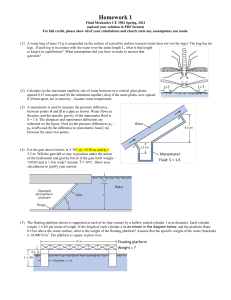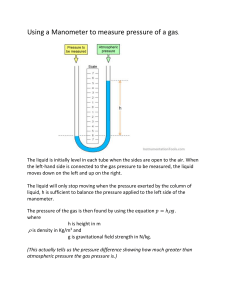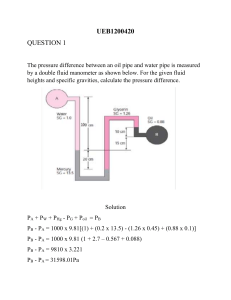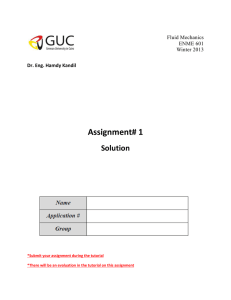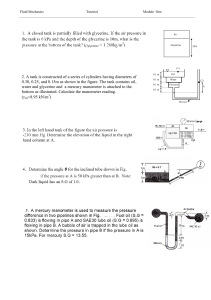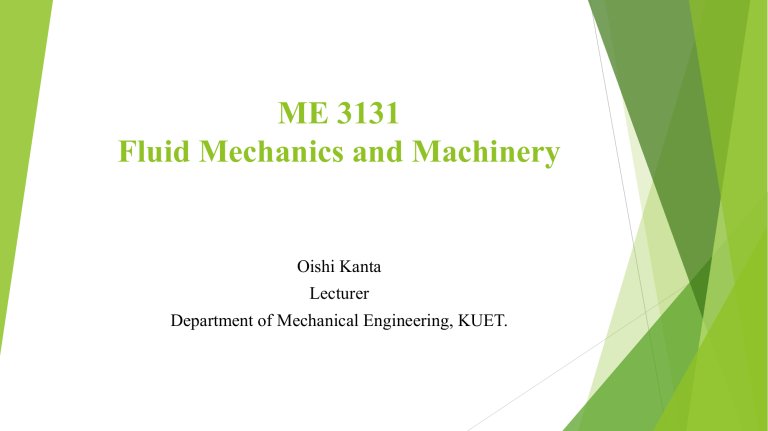
ME 3131 Fluid Mechanics and Machinery Oishi Kanta Lecturer Department of Mechanical Engineering, KUET. Introduction • When fluid is at rest or in rigid body motion (moving in such a manner that there is no relative motion between the adjacent particles): • Fluid particles retain their identity and do not deform. • Viscosity has no effect on the fluid behaviour. • There is no shear stresses present but only pressure forces exist. • Pressure generated within a static fluid is an important phenomenon in many practical situations. After completing this chapter, you should be able to: • Deduce properties of the atmosphere and oceans. • Develop instruments (manometers) for measuring pressures. • Compute hydrostatic pressure forces on plane or curved submerged surfaces (gates, dames etc.) • Calculate buoyant force and determine the stability of floating or submerged objects. Pressure at a Point • z y Forces on an arbitrary wedged-shaped element of fluid. Forces in the x direction are not shown for simplicity Pressure at a Point • Basic Equations of Fluid Statics • p Basic Equations for Pressure Field • Basic Equations for Pressure Field • Thus, the resultant surface force per unit volume can be expressed as • The weight of the element is (since z axis is vertical) B • Newton’s 2nd law applied to the fluid element, can be expressed as B • This is the general equation of motion for a fluid in which there are no shearing stresses Pressure Variation in a Fluid at Rest • For a fluid at rest acceleration a = 0, the general equation reduces to • In component form • These equations show that the pressure does not change from point to point in a horizontal plane. Since p depends only on z, the last equation can be written as the ordinary differential equation • Pressure gradient in the vertical direction at any point in a fluid depends only on the specific weight and this equation can be used to determine the change of pressure with elevation Pressure Variation in Incompressible Fluid • For liquids the variation in density is usually negligible. Moreover, for most engineering applications the variation in g is negligible. So the specific weight ( ) of liquids can be assumed as constant • Integrating the fundamental equation of fluid statics, Pressure p at any depth h below the free surface is given by the equation: • Pressure difference between two points in a static incompressible fluid can be determined by measuring the elevation difference between the two points. Devices used for this purpose are called manometers Pressure Variation in Incompressible Fluid • For incompressible fluid at rest the pressure varies linearly with depth of fluid, h measured positive downward to some reference plane • Pressure is not influenced by the size or shape of the tank or container in which the fluid is held a) Pressure of a fluid at rest increases with depth (as a result of added weight) b) The pressure is the same at all points on a horizontal plane in a given fluid regardless of geometry, provided that the points are interconnected by the same fluid Pressure Variation in Incompressible Fluid • Pressure Variation in Compressible Fluid • In gases, density varies with pressure and temperature, proper integration of fundamental equation is needed employing the ideal gas equation that governs the variation of density with the variation of pressure and temperature in gases Pressure Variation in Compressible Fluid For small to moderate distances, variation of pressure with height is negligible for gases because of their low density In a room filled with a gas, the variation of pressure with height is negligible Pressure Variation in Standard Atmosphere • The standard atmosphere is an idealized representation of mean conditions in the earth’s atmosphere (p=0.1 kPa) (p=0.9 kPa) (p=5.5 kPa) (p=22.6 kPa) (p=101.3 kPa) Temperature variation with altitude in the U.S. Standard Atmosphere Pressure Variation in Standard Atmosphere • m m where po is the pressure at sea level, z = 0 • Using the values of pressure and temperature from the Table at sea level, the absolute pressure at the outer edge of the troposphere can be calculated as about 22.6 kP Measurement of Pressure • Pressure is designated as either absolute pressure or gage pressure • Absolute pressure is measured relative to a perfect vacuum such as in outer space (absolute zero pressure) • Gage pressure is measured relative to the local atmospheric pressure. Thus, a gage pressure of zero corresponds to a pressure that is equal to the local atmospheric pressure ▪ Absolute pressures are always positive, but gage pressures can be either positive or negative depending on whether the pressure is above atmospheric pressure (a positive value) or below atmospheric pressure (a negative value). A negative gage pressure is also referred to as a suction or vacuum pressure ▪ For example, 69 kPa (abs) could be expressed as -32.3 kPa (gage), if the local atmospheric pressure is 101.3 kPa, or alternatively -32.3 kPa suction or -32.3 kPa vacuum Measurement of Pressure • Measurement of atmospheric pressure is usually accomplished with a mercury barometer, which in its simplest form consists of a glass tube closed at one end with the open end immersed in a container of mercury • The tube is initially filled with mercury (inverted with its open end up) and then turned upside down (open end down) with the open end in the container of mercury • The column of mercury will come to an equilibrium position where its weight plus the force due to the vapor pressure (which develops in the space above the column) balances the force due to the atmospheric pressure • In the SI system, unit of pressure is N/m2 and this combination is called the pascal written as Pa Fig: Mercury barometer Measurement of Pressure • Pressure measuring devices are broadly classified as • Manometers: Based on the principle of balancing liquid column by the same or another column of liquid) • Mechanical gages: Make use of the idea that when a pressure acts on an elastic structure the structure will deform, and this deformation can be related to the magnitude of the pressure • Manometers are classified as • Simple manometers (measures pressure at a point in a fluid) • Differential manometers (measures differences of pressure between any two points in a fluid) • Three common types of manometers include the piezometer tube, the U-tube manometer, and the inclined-tube manometer • Since manometers use vertical or inclined liquid columns of fluids at rest to measure pressure, the fundamental equation describing their use is below. If h is the depth between two general points 1 & 2, then Analyzing Manometers To find the pressure at some point in the system, the following steps are recommended: • Label all points where the fluid changes • Start from a point where you know the pressure • Move from this point to another point within the same fluid and apply the static law to find the pressure at the new point • Progress until you reach the point of interest and note that as you go down pressure increases and as you go up pressure decreases Points to Keep in Mind • If the manometer is inclined, only the change in height between the points are to be taken, not the actual length of the pipe • Remember that points at the same horizontal level within the same fluid have the same pressure • Pressure variation within gases can be ignored Piezometer Tube • Simplest type of manometer consists of a vertical tube, open at the top, and attached to container in which the pressure is desired the • Application of the static law to the piezometer tube indicates that the pressure pA can be determined by a measurement of h1 through the relationship • Disadvantages of Piezometer are ▪ Only suitable to measure pressure greater than atmospheric pressure ▪ Relatively small pressure can be measured so the required height of the column is reasonable ▪ Pressure of the fluid in the container to be measured must be a liquid rather than a gas Fig: Piezometer tube Since the tube is open at the top, gage pressure can be obtained by setting p0 equal to zero U-Tube Manometer • To overcome the difficulties noted previously, another type of manometer which is consists of a tube formed into the shape of a U widely used • The fluid in the manometer is called gage fluid. Two common gage fluids are water and mercury • Combining all the equations gives absolute pressure at A • Or, the gage pressure Figure: Simple U-tube manometer U-Tube Manometer • The U-tube manometer is also widely used to measure the difference in pressure between two containers or two points in a given system • The difference in pressure between A and B can be found by again starting at one end of the system and working around to the other end • Because the liquid level change is small at low pressure differential, a U-tube manometer may be difficult to read accurately due to capillary action • Capillary rise can be negligible by using relatively large bore tubes (with diameters of about 0.5 inch or larger) Fig: Differential U tube manometer Inclined Tube Manometer • Fig: Inclined tube manometer Manometers • Manometer sensitivity: ✔ Sensitivity of a manometer is a measure of how sensitive it is compared to a simple water-filled U-tube manometer. Specifically, it is the ratio of the deflection of the manometer to that of a water filled U-tube manometer, due to the same applied pressure difference Δp • Enhancing manometers sensitivity: ✔ Use liquids with low density and low surface tension, use inclined manometers, use low ratio of manometer tube diameter d to reservoir diameter D Mechanical Pressure Measuring Devices • Manometers are not well suited for measuring very high pressures, or pressures that are changing rapidly with time. In addition, reading one or more column heights in manometers can be time consuming • The most familiar mechanical pressure measuring device is the Bourdon pressure gage which make use of the idea that when a pressure acts on an elastic structure the structure will deform, and this deformation can be related to the magnitude of the pressure • The essential mechanical element is the hollow, elastic curved tube (Bourdon tube) which is connected to the pressure source in one end and the closed end is connected to a dial indicator needle • When the tube is open to the atmosphere, the tube is undeflected, and the needle on the dial at this state is calibrated to read zero (gage pressure). When the fluid inside the tube is pressurized, the tube stretches and moves the needle in proportion to the pressure applied Fig: Various types of Bourdon tubes used to measure pressure Problem Illustration • Problems of Manometer Problems of Manometer Problems of Manometer Solution: Hydrostatic force on a Horizontal Plane Surface • When a surface is submerged in a fluid, forces develop on the surface due to the hydrostatic pressure distribution on the surface • Determination of these forces is important in the design of storage tanks, ships, dams, and other hydraulic structures • For a horizontal surface, e.g., bottom of a liquid-filled tank, magnitude of the resultant force acts through the centroid of the area • Hydrostatic pressure force at the bottom surface Fig: Pressure and resultant hydrostatic force developed on the bottom of an open tank Hydrostatic force on a Vertical Plane Surface • Fig: Pressure of a fluid at rest increases with depth (as a result of added weight) Hydrostatic force on a Inclined Plane Surface • z y Fig: Notation for hydrostatic force on an inclined plane surface of arbitrary shape Hydrostatic force on a Inclined Plane Surface • z y Hydrostatic force on a Inclined Plane Surface • Hydrostatic force on a Inclined Plane Surface • The integral in the numerator is the second moment of the area (moment of inertia), Ix, with respect to x axis • Using the parallel axis theorem to express Ix as • where Ixc is the second moment of the area with respect to an axis passing through its centroid and parallel to the x axis. Thus, • The resultant force does not pass through the centroid but rather for non-horizontal surfaces is always below it, since Hydrostatic force on a Inclined Plane Surface • The x coordinate, xR for the resultant force can be determined in a similar manner by summing moments about the y axis. • where Ixyc is the product of inertia with respect to an orthogonal coordinate system passing through the centroid of the area • The point through which the resultant force acts is called the centre of pressure. • Geometric properties of some common shapes as shown Hydrostatic force on Submerged Curved Surfaces • Hydrostatic force on Submerged Curved Surfaces • Hydrostatic force on Submerged Curved Surfaces • Problem Illustration • A 5 ft wide gate is hinged at point B, and rests against a smooth wall at point A. Compute (a) the force on the gate due to seawater pressure, (b) the horizontal force P exerted by the wall at point A, and (c) the reactions at the hinge B. Problem Illustration • A 4-m long curved gate is located in the side of a reservoir containing water. Determine the magnitude of the horizontal and vertical components of the force of the water on the gate. Problem Illustration • A long solid cylinder of radius 0.8 m hinged at point A is used as an automatic gate. When the water level reaches 5 m, the gate opens by turning about the hinge at point A. Determine (a) the hydrostatic force acting on the cylinder and its line of action when the gate opens. Problem Illustration • A tank of oil has a right-triangular panel near the bottom. Omitting pa, find the (a) hydrostatic force and (b) CP on the panel. Problem Illustration • Buoyancy and Stability • Immersed body in static liquid Buoyancy and Stability • Illustrative Problem • Consider the free-body diagram of the concrete block. The forces acting on the concrete block in air are its weight and the upward pull action (tension) by the rope. These two forces must balance each other, and thus the tension in the rope must be equal to the weight of the block: • When the block is immersed in water, there is the additional force of buoyancy acting upward. The force balance in this case gives • Note that the weight of the concrete block, and thus the tension of the rope, decreases by (10.8 - 6.0)/10.8 = 55% in water. A crane is used to lower weights into the sea (density = 1025 kg/m3) for an underwater construction project. Determine the tension in the rope of the crane due to a rectangular 0.4-m × 0.4-m × 3-m concrete block (density = 2300 kg/m3) when it is (a) suspended in the air and (b) completely immersed in water Illustrative Problem A yellow pine rod (SG = 0.65) is 5 cm by 5 cm by 2.2 m long. How much lead (SG = 11.4) is needed at one end so that the rod will float vertically with 30 cm out of water? Stability of Immersed and Floating Bodies • An important application of the buoyancy concept is the assessment of the stability of immersed and floating bodies with no external attachments. It is of great importance in the design of ships and submarines • The “ball on the floor” analogy to explain the fundamental concepts of stability and instability. The stability can be determined by considering what happens when a body is displaced from its equilibrium position. • Case (a) is stable since any small disturbance (someone moves the ball to the right or left) generates a restoring force (due to gravity) that returns it to its initial position. • Case (b) is neutrally stable because if someone moves the ball to the right or left, it would stay put at its new location. It has no tendency to move back to its original location, nor does it continue to move away. • Case (c) is a situation in which the ball may be at rest at the moment, but any disturbance, even an infinitesimal one, causes the ball to roll off the hill-it does not return to its original position; rather it diverges from it. This situation is unstable. A ball on the floor analogy to understand stability Stability of Immersed Body • For an immersed or floating body in static equilibrium, the weight W and the buoyant force FB acting on the body balance each other, and such bodies are inherently stable in the vertical direction. • The rotational stability of an immersed body depends on the relative locations of the centre of gravity G of the body and the centre of buoyancy B, which is the centroid of the displaced volume. • Since B and G do not necessarily coincide, a small rotation can result in either a restoring or overturning couple of W and FB. • An immersed body is stable if the body is bottom-heavy and thus point G is directly below point B. • A rotational disturbance of the body in such cases produces a restoring moment to return the body to its original stable position. • Thus, a stable design for a submarine calls for the engines and the cabins for the crew to be located at the lower half in order to shift the weight to the bottom as much as possible. • Hot-air or helium balloons (which can be viewed as being immersed in air) are also stable since the cage that carries the load is at the bottom. Stability of Immersed Body • An immersed body whose centre of gravity G is directly above point B is unstable, and any disturbance will cause this body to turn upside down. • A body for which G and B coincide is neutrally stable. This is the case for bodies whose density is constant throughout. For such bodies, there is no tendency to overturn or right themselves. Stability of Floating Body • The rotational stability criteria are similar for floating bodies, but more complicated. A floating body is always stable if point G is directly below point B like immersed bodies. • But unlike immersed bodies, a floating body may still be stable when G is directly above B. • For floating bodies, point G remains unchanged, but the location of point B changes to pass through the centroid of the displaced volume for any rotational disturbances. • As the body rotates, the buoyant force, FB shifts to the side passing point B, combines with the weight, W to form a couple, which will cause the body to return to its original equilibrium position. W W B B B B Stability of a floating body—stable configuration Stability of Floating Body • A measure of stability for floating bodies is the metacentric height GM, which is the distance between the center of gravity G and the metacenter M. • Metacenter is the intersection point of the lines of action of the buoyant force, FB through the body before and after rotation. • Metacenter may be considered to be a fixed point for small rolling angles up to about 20°. • A floating body is stable if point M is above point G, and thus GM is positive. • The length of the metacentric height GM above G is a measure of the stability: the larger it is, the M more stable is the floating body. W W B B B B Metacentre and metacentric height-a measure of stability Stability of Floating Body • However, for relatively tall slender body, a small rotational displacement can cause the weight and the buoyant force acting on the tilted body generate an overturning moment instead of a restoring moment, causing the body to capsize. • In this case, metacenter, M is below the centre of gravity, G, and thus GM is negative causing the body unstable. • A floating body can tilt to some maximum angle without capsizing, but beyond that angle it overturns and sinks like the analogy as shown in figure. W W G M Stability of a floating body—unstable configuration Bʹ B B B A ball in a trough between two hills is stable for small disturbances, but unstable for large disturbances Determination of Metacentric Height (Theoretical Method) • • Assumptions of derivation: • The body has a smooth shape variation (no discontinuities) near the waterline. • The y-axis of the body is assumed to be a line of symmetry. Determination of Metacentric Height (Theoretical Method) • • Problem Illustration A wooden cylinder (SG = 0.6) 1m in diameter and 0.8m long. Would this cylinder be stable if placed to float with its axis vertical in oil (SG = 0.85)? Problem Illustration An iceberg can be idealized as a cube of side length L as shown. If sea water is denoted as SG = 1.0, the iceberg has SG = 0.88, Is it stable? Problem Illustration • • G B Problem Illustration • w/2 r G B w y
